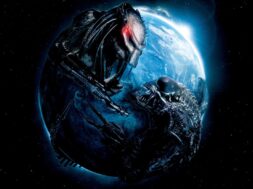‘The Ninth Configuration,’ William Peter Blatty’s surreal meditation on faith, as well as an ‘Exorcist’ pseudo sequel, still holds up 40 years later.
“Everything A-OK there, spaceman?”
Current entertainment culture is out of control. There was a point when sequels were inevitable for popular films and maybe a beloved blockbuster would garner a prequel, but now these practices are merely part of the norm. There are “legacy sequels” to properties like Honey, I Shrunk the Kids, Candyman, and The Mighty Ducks happening, which definitely weren’t series that were filled with unresolved questions. At the same time, prequel projects are being designed around characters like Nurse Ratched from One Flew Over the Cuckoo’s Nest, Die Hard’s John McClane, and Mr. Wing from Gremlins.
Nowadays, if a franchise was ever remotely popular at some point then that means that it basically qualifies to be trotted back out on display, usually with some tangential, manipulative connection to the original franchise. Accordingly, a pseudo-sequel to The Exorcist that doesn’t follow Regan or anyone connected to the Catholic Church, but rather that random astronaut that she shouts at for ten seconds at the MacNeil’s dinner party actually sounds exactly like the kind of money-driven nostalgia grab that would happen in today’s climate. And yet, this idea happened forty years ago when this technical sequel to The Exorcist, written by the original author no less, happened to come out only a few years after the actual Exorcist II.
The Ninth Configuration’s story, in terms of plot points, is incredibly threadbare. The notorious Colonel Kane (Stacey Keach, in what might be his best work) gets stationed to become the new military psychiatrist at a particularly unusual VFW center full of troubled veterans. Among them is Billy Cutshaw (Scott Wilson), an astronaut who’s caught in the middle of a crisis of faith that has effects that ripple throughout the center and force both Kane and Cutshaw to confront themselves and their values in unexpected, challenging new ways.
William Peter Blatty‘s journey with The Ninth Configuration first began in 1966 when he published the novel, Twinkle Twinkle, “Killer” Kane! with the plans to turn it into a film he’d write and William Friedkin would direct. When no studios would take a chance on the project, the potential film languished and Blatty and Friedkin would instead pivot to The Exorcist. Curiously, the experience inspired Blatty to rewrite Twinkle Twinkle, “Killer” Kane! and turn Cutshaw into the astronaut from The Exorcist. Blatty would eventually republish his novel in 1978 as The Ninth Configuration, which he then attempted to find financing for and turn into a feature film one last time.
William Peter Blatty didn’t direct many films, but he put his all into every one of his movies. Blatty’s directorial debut, The Ninth Configuration, may not be his scariest piece of work, but it does feel like his purest and most authentic film. The Ninth Configuration plays around with several strong ideas, but it’s really the ultimate film that pits science against religion (surpassing the heights of movies like Contact or the more recent First Reformed—which was coincidentally done by Paul Schrader, who handled Dominion: Prequel to the Exorcist). It explores these extremes and the dissonance that’s caused by the film’s chaotic balancing act between careful comedy and drama.

Very powerfully, The Ninth Configuration seems to directly address Regan’s warnings and theories from The Exorcist (“You’re gonna die up there!”), but in a justified way that supports the new ideas and themes of this film through the prism of Cutshaw. The Exorcist suggests one of the loneliest fates is to be possessed by a demon and die like that, understanding that dark forces exist, but that they’re also more powerful than God or his ability to save you. The Ninth Configuration takes this idea even further and introduces to it the cold, sterile vicinity of outer space. Cutshaw’s greatest fear isn’t possession or to face a demon, but rather his knowledge of the emptiness of the universe.
A world without God or a higher power is depressing enough, but Cutshaw’s nightmare places him alone on the moon with these thoughts. He’s not just physically isolated, but he’s left on the loneliest place in existence as he’s left to ponder the world’s theological and spiritual emptiness. The addition of the ultimate symbol from Catholic faith, the crucifixion, turns this into an incredibly bleak, powerful image. It doesn’t just feel like something from out of a Kubrick film or Hideaki Anno anime, but it’s also arguably a more evocative image than anything out of the original Exorcist.
When Cutshaw is asked why he won’t go to the moon, his response is one of the most moving monologues from the film:
“Because I’m afraid…See the stars…So cold. So far. And so very lonely. Oh, so lonely. All that space. Just, empty space. And so far from home. I’ve circled around and around this house. Orbit after orbit. And sometimes I’d wonder what it would be like never to stop. And circle alone up there forever. And what if I got there, got to the moon…and couldn’t get back? Sure, everyone dies. But I’m afraid to die alone so far from home. And if there’s no God, then that’s really, really alone.”
This moving confession by Cutshaw is left for the final fifteen minutes of the film and not after his prophetic dream is first seen. Blatty wants this stark, sobering question to be what stays with the viewer as the credits (and existence) cut to black. And even though these final moments also attempt to prove a true affirmation of God’s existence, when this follows so much absurdity, chaos, and doubt, it’s hardly an empowering message.

This is underscored even further by the ultra-bleak ending where it turns out that this “good act of God” is actually Cutshaw’s death by his own hand. Cutshaw is convinced that the emptiness of the world is too heavy to take on, but that his exit can help inspire people like Kane to survive and keep on fighting. Regan’s message to Cutshaw all the way back in The Exorcist comes true after all. Maybe she even saw this conclusion for him.
On top of these heavy thoughts, The Ninth Configuration really tries to get lost in the free-floating chaos and madness of the VFWs. At times the movie seriously feels like Full Metal Jacket meets One Flew Over the Cuckoo’s Nest, but with the sense of humor of Airplane! and directed by David Lynch. This culminates into a strange, uncomfortable hybrid of a film, but one that wants you overwhelmed and put off by this schism of tones and styles. Even the fact that the movie is literally set in a castle, and not some typical VFW station, speaks to the gothic, extravagant nature of it all.
The VFW castle in question is impossibly eerie and does not at all seem conducive to mental rehabilitation. It’s safe to say that during this film none of the characters feel like they’re in the right place. Music is constantly used to disorient or be anachronistic to further the feeling of confusion and unease. There are frequent close ups on gothic statues or horrid gargoyles, as if they’re no different than the tortured souls that are stuck in there who become less and less human.
These instincts are perhaps most apparent in the film’s intense images, which are some of the craziest visuals you’ll see; they even manage to rival the madness of Exorcist III’s more lucid sequences. A character will randomly ride a motorcycle in or out of a building only for it to be not addressed at all. There’s Nazi roleplay, Shakespeare productions performed entirely by dogs, people in superhero costumes, and what might literally be the most surprising and claustrophobic bar fight that’s ever been committed to film. It’s a movie that actually makes you feel like you’re going crazy, at certain points. Even the film’s final image is a joyful freeze frame that’s just so bizarre and feels tonally off from what comes before it.

The visuals in The Ninth Configuration go far, but there are also so many powerful, methodical monologues about humanity, faith, and loneliness. At times the film really feels like a super depressing Samuel Beckett play that’s been filmed with a higher budget and occasionally trippy effects. Most of the dialogue in the film honestly feels like it’s spoken in metaphors or just anecdotal ramblings on topics like PT Barnum or if pain makes turkeys noble as the audience is left to try to figure out what all of this means. It’s a Magic Eye painting, but for your ears to suss the message out between the madness. It’s like you’re lost in a chorus of crazy people as you try to search for the right way to the narrative.
At times it’s almost as if everyone is acting in different movies that have been stitched together through insanity, which is the perfect tone for this film. This speaks to the more grounded quality of the material and how it is so dialogue-based as characters talk through their pain, analyze dreams, and debate their various traumas. Even the competent, sane characters give asides to skulls like they’re Shakespeare characters.
To go one step further with that thread, Blatty makes the allusions to Shakespeare, specifically Hamlet (the scribe’s own ode to mental illness), explicit with The Ninth Configuration. The film even essentially tells the audience to go through the same experience that one does when viewing Hamlet and to use their own judgment as to whether these characters are actually crazy or not. In fact, enough time is spent on the trials and tribulations of the dogs’ Shakespeare productions that they’re basically a secondary storyline and a major concern for most of the main characters.
Since so much of The Ninth Configuration revolves around corralling the VFWs and making sure that everyone is stable, it’s deeply jarring when the film briefly leaves the VFW center. It’s like that weird moment in Who’s Afraid of Virginia Woolf? when everyone temporarily leave the house. It feels wrong. What should be a freeing moment makes the film feel even more trapped. The whole bar fight detour is such a bizarre non sequitur that resorts in the most bloodshed of the entire film and it’s a moment that arguably doesn’t even need to be in there. It’d be like if in the middle of The Exorcist Father Karras and Father Merrin decided to go out for a beer and then got caught up in a ridiculous armed robbery while they’re there, only to brush it all off as they head back home later. It once again speaks to Blatty’s freewheeling instincts as a director.
The Ninth Configuration continues to feel like it just moves through Blatty due to how all of the allusions to other cinema that the film makes weren’t scripted, but rather came to Blatty while they were filming. This speaks to how personal and visceral this project (and all of his novels) were to him. At times it looks like Blatty doesn’t know what he’s doing or that his directorial instincts are poor, but it also feels so instinctual and even when it doesn’t work, it still builds to the larger picture of chaos that Blatty wants to create. It’s exactly because he has so little experience as a director that he’s able to bring this personal story to life in such an atypical way. I seriously can’t imagine how this film would look if it was helmed by any other director.

Blatty may have wanted Friedkin to tackle this at one point, but I don’t think he would have elevated the material in nearly the same way. A lot of the strange, dark humor would probably be absent, for one. It’d probably feel like a much more conventional movie, which is exactly what this film tries so hard to avoid. The Ninth Configuration feels deeply entwined in Blatty like he’s the only one who could make it. It’s not at all surprising to learn that when studios were concerned about Blatty’s vision he resorted to co-financing the film himself, with the help of PepsiCo, who were really just interested in setting up more factories in Budapest, Hungary. It’s extremely bizarre that this film about faith ended up having more of an impact on a commercial soft drink company than anything else.
One of the final moments in the film impressively shows Kane quietly reflect and mourn, yet it’s one of the most frightening scenes in the movie. Blatty plays with sound design and silence to create pure tension and make Kane feel like he isn’t completely alone during this moment of grief. Curiously, both Blatty’s The Ninth Configuration and The Exorcist III conclude with an older gentleman mourning the death of his longtime friend while their posthumous words are supposed to inspire hope. It’s a powerful idea that these eternal evils are so overwhelming that both stories need to take a major life to help provide the other protagonist with their necessary epiphany.
It’s worth discussing that there’s an alternate edit of the film that’s been released that attempts to credit Cutshaw’s death to injuries from the bikers at the bar. Not only does Blatty not approve of this version of the film, but this edit really undercuts the message of Cutshaw crumbling to the weight of the world. Strangely, many Exorcist productions have struggled with censorship and forced edits that drastically change the story, but thankfully The Ninth Configuration’s message does get to live and hasn’t been erased.
The Ninth Configuration is undeniably an unusual experience, and if you’re looking for a straight sequel to The Exorcist than this is inevitably going to disappoint. However, in terms of acting as a bleak extension of The Exorcist’s themes and a meditation on the dark ideas that the film introduces, The Ninth Configuration is a fantastic companion piece. The film adds an even richer and more cosmic picture to the larger Exorcist mythos, if you then choose to watch the other films afterwards. It expands on the material, without breaking it, and for that it is successful. It’s just a much more cerebral horror than what’s explored in any of the other films in the series.
40 years later, in an increasingly nihilistic world, The Ninth Configuration doesn’t just hold up, but it’s a film that demands even more of an audience.










